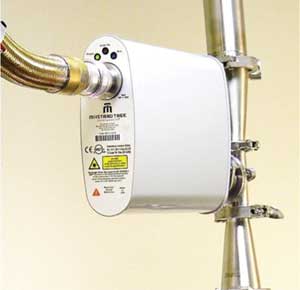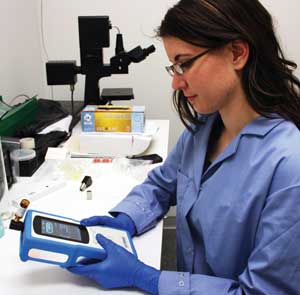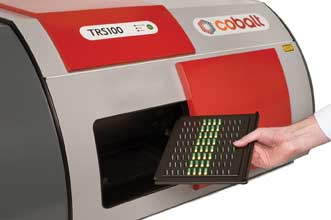Can the latest developments in optical spectroscopy overcome the mounting regulatory hurdles afflicting the pharmaceutical business?
Optical spectroscopy has long been a crucial tool for drug development as well as drug inspection and testing, and the past decade has seen a testing trend emerge: Ever-more-stringent regulatory controls have meant that some drug companies are slow to adopt, or invest in, new methods and instrumentation.
The dilemma is that most of today’s products are not fully tested until they are in finished product form – often in their packaging – so adopting the latest cutting-edge optical spectroscopy technique can be imperative.

Spatially offset Raman spectroscopy allows the contents of a product to be analyzed through packaging. Courtesy of Cobalt Light Systems.
Typical techniques used in pharmaceutical sciences are ultraviolet/visible absorbance, near-infrared (NIR), Fourier transform infrared, Raman and fluorescence spectroscopy. These optical methods are used for moisture analysis, materials identification, reaction monitoring and determining molar concentration, to name a few.
Such techniques replace slower and more costly approaches to drug development and testing such as human inspection, high-performance liquid chromatography (HPLC), infrared spectroscopy and gas chromatography.
Raman spectroscopy
For Robert Chimenti, marketing manager at B&W Tek of Newark, Del., the technique getting the most attention is Raman spectroscopy, in particular, portable instrumentation for identifying and verifying materials in the ever-expanding global supply chain.
“The increasing pressure on pharmaceutical companies for cost reduction forces supply chain managers to go overseas in order to achieve the highest degree of cost saving,” he said. “The resultant complex supply chains have inadvertently increased the probability of improper or counterfeit raw materials reaching the warehouse.”
The Raman effect provides a unique molecular fingerprint, allowing for rapid screening of materials at the point of receipt for easy, fast and accurate identification of these nonconforming materials before they reach production.
A single instrument from pharmaceutical and chemical analysis specialist Mustard Tree Instruments LLC of Research Triangle Park in North Carolina combines machine vision, color and Raman analysis in a single package. Company founder Todd Blonshine believes that Raman is a fundamental spectroscopy technique that has many useful functions, making it valuable for drug development as well as for inspection and testing.

The washable, removable, rugged and Class I-/Division 1-rated Raman spectrometer from Mustard Tree Instruments is shown installed in a sanitary process line. Courtesy of Mustard Tree Instruments.
“One that is most often noted is that it can be used to determine crystal form (polymorphism), which is critical for both bioavailability as well as intellectual property reasons,” Blonshine said.
“We are working with many solid and liquid formulations that can be quantified nondestructively via Raman and visible spectroscopy,” he added. “For instance, active ingredients such as alcohols can be set up and measured in less than a minute, whereas the corresponding work on HPLC or gas chromatography takes hours. This analysis, if Raman is used, also can be used to verify content. Cost per sample is virtually eliminated. Waste is reduced dramatically.”
The pharmaceutical industry is a very competitive market, made even more complex by the need to cut costs and keep sustainability in mind, and to understand and adhere to regulations.
“Sustainability is not just about doing the right thing for the environment; it is also a serious economic driver for improved profitability, employee morale and environmental compliance,” Blonshine said. “Using nondestructive and rapid technologies, such as those optical spectroscopies mentioned, eliminates the hazardous wastes of many testing technologies and allows the product to be tested as it is being produced, reducing risk that waste or unusable product would be generated.”
Drug development and drug discovery increasingly require up-front investment, which means there is more and more pressure to trim excess costs wherever possible.
For B&W Tek’s Chimenti, this means that a major consideration when making any capital investment is the speed at which the product will provide a return on investment.

Handheld Raman spectrometers provide a fast return on investment, which makes the technology promising for use in the pharmaceutical space. Courtesy of B&W Tek.
“Handheld Raman spectrometers have proven to produce an extremely fast return on investment,” he said. “As a result, this technology is showing a lot of promise in the pharmaceutical space.”
Analyzing tablets and packaging
Two of the latest Raman techniques offered by Cobalt Light Systems of Oxfordshire, England, are transmission Raman spectroscopy (TRS) and spatially offset Raman spectroscopy (SORS). TRS enables quantitative tablet and capsule testing in seconds, while SORS enables the identification of raw materials through unopened containers.
“Tablet manufacture is harder than you would think, and analyzing the tablets to make sure they have the right amount of active ingredient is expensive and slow,” said founding director Darren Andrews. “To determine composition typically requires wet chemistry techniques such as HPLC, which requires skilled users and many hours to complete.”
TRS allows the amount of active drug in a finished tablet, capsule or other dosage form to be measured in seconds, even for large, thick samples. Crucially, the technique works without dissolving or otherwise preparing the sample.
“The analysis is very fast, reliable, not subject to user error and far lower in cost than conventional HPLC measurements,” Andrews said. “This is of significant interest to generics manufacturers, as the cost of HPLC testing is significant and otherwise unavoidable. NIR has failed to make significant inroads in this area due to the difficulties of using it; TRS is much easier – you can even do it through capsules. Our instrument – the TRS100 – is designed for production environments and complies with regulatory guidelines.”

Transmission Raman spectroscopy allows the amount of active drug in a finished tablet or capsule to be measured without the need to dissolve or otherwise prepare the sample. One instrument that can do this is the Cobalt TRS100. Courtesy of Cobalt Light Systems.
SORS, which can be found in Cobalt Light Systems’ RapID product, is used for analyzing through unopened packages. This is particularly interesting for high-volume and sterile/parenteral manufacture. This is a unique technique, Andrews said.
“There is no other way to routinely identify materials through nontransparent containers such as paper sacks and white or colored plastic bottles,” he said. “We can ID the contents of unopened paper sacks in seconds without cutting into it or opening it. This saves a huge amount of cost, as opening the packages is time-consuming and requires specialist handling booths to achieve. There are also benefits in plant safety and in eliminating the risk of contamination during testing.”
Near-infrared spectroscopy
Infrared spectroscopy uses wavelengths ranging from 800 to 4000 nm to obtain general information about the chemical structure of a compound in question. NIR spectroscopy, on the other hand, makes use of wavelength ranges up to 25,000 nm, which means that information about specific locations for particular functional groups can be obtained.
In the research arena, NIR spectroscopy generally is used for simple identification and detection of counterfeit pharmaceuticals. But the unique properties of NIR spectroscopy also make it suitable for monitoring many manufacturing processes, such as general production of medicinal products, fluidized-bed granulation (wet, in-line), mixing, spraying and drying.
NIR spectroscopy enables drug developers to determine physicochemical parameters such as particle size in powders and tablets, water content, relationship between the amorphous and crystalline forms of active pharmaceutical ingredients, and more.
Many parameters of medicinal products are also commonly controlled with NIR spectroscopy, including hardness, porosity, size, compressive strength and disintegration time.
“NIRS application is crucial for verification and connection between at- and online results during drug development,” said Marzena Jamrógiewicz, who is a member of the pharmacy faculty at the Medical University of Gdansk in Poland. “Near-infrared spectroscopy is a significant alternative for the classical analytical methods. Because of its speed, low cost and nondestructive characteristic towards the analyzed sample, it is recommended as a first-choice method in analytical laboratories.”
The promising technique has encountered a stumbling block, however, as Jamrógiewicz points out. NIR spectroscopy has received some bad publicity as a “black box” technique, whereby its results are obtained without proper knowledge of a mechanism or of verification of the system’s components.
“Moreover, it is often said that chemometric correlation requires a lot of faith in numbers that many spectroscopists do not possess,” Jamrógiewicz said. “Current software allows development of NIR spectroscopy methods with minimal understanding of the relevant chemometrics, which creates a high risk of obtaining invalid results due to some unknown hidden variables. Making a lot of analyses on a modern instrument without advanced courses about proper usage of complicated software may be in fact a totally bad experience.”
Regulations threaten to stall market
Challenges facing the pharmaceutical market are manifold but seem to have one thing in common: extensive regulation. The market has taken a hammering in the past few years, particularly in those countries with a difficult economy, according to Cobalt Light Systems’ Andrews.
The fallout means that companies are slow to embrace new technologies, delayed by having to navigate their way through some of the compliance rules that have been set in place in recent years.
“The primary challenge for the adoption of new techniques is the extensive validation requirements set forth by the FDA and other governing bodies,” Chimenti said. “Some instrumentation providers, such as B&W Tek, are helping to mitigate this process by offering on-site method/library development, validation services and IQ/OQ [installation and operational qualification] implementation.”
Unless particular focus is applied to solving a problem, the adoption cycle is glacial at times, Blonshine at Mustard Tree Instruments said.
“Usually, this hesitancy is generated from regulatory concern. Combined with this is the outsourcing to very lean organizations and the leaning still of organizations that once had bandwidth to study a problem and find a solution,” he said.
On the other hand, as Chimenti noted, without mandatory regulations, companies would not do any of the testing at all.
“So, while [regulations] make pharma more difficult than other markets, they are actually the main reason that the use of techniques like Raman have blown up over the past ten years,” he said.